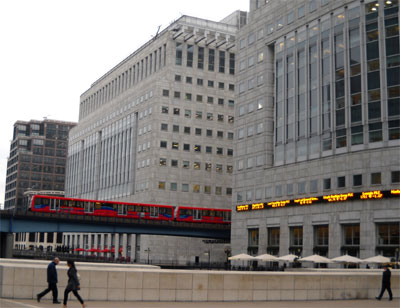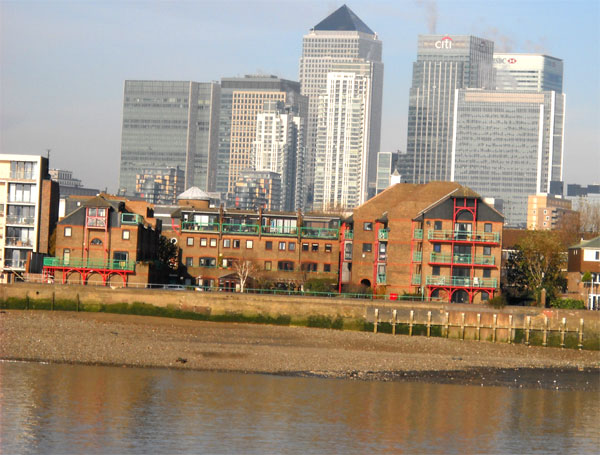This article gives an overview of the new city district and shows why visiting the Docklands is a great thing for tourists.
What are the Docklands?
The port used to be: London once had the largest cargo port in the world. In the east of the city were huge areas of London for a long time port area. After 1960, when more and more large container ships conquered the oceans, the Docklands experienced an unprecedented and rapid decline. The Thames and the Docklands were too small and too narrow for the new large cargo ships.
The Docklands today: The site was destroyed, tens of thousands of dock workers became unemployed. The British government under Thatcher decided to take a radical and courageous step. A new, gigantic district was to be built. Tax relief, billions of pounds of public funds, and London’s rise to become the financial capital of Europe all led to a unique real estate boom. Huge office buildings, shopping centres, luxury apartments, marinas and other buildings were built in gigantic dimensions: The three highest skyscrapers of Great Britain are located in the Docklands (200 – 240 meters high). In a good 20 years, the Docklands have gone from being one of the most run-down areas of the country to one of the most modern districts in the western world.
Moving company in Siegburg – Alpha relocation

The most popular boat trip on the ThamesA large proportion of London tourists now take a boat trip on the Thames. Of course, everyone wants to see central London from the ship. The most popular boat tour is therefore from Westminster to Greenwich, i.e. across central London. Very frequently booked tour, you should book online beforehand: >>> At Getyourguide.de there are tickets for the ships on the Thames |
The center of the new Docklands
The heart of the new Docklands is the Isle of Dogs. The Canary Wharf building complex is located on the island. In addition to “One Canada Square”, the highest building in Great Britain at almost 240 metres, around 30 other large buildings were erected here. In and around Canary Wharf alone, 100,000 people are currently working, mainly in offices.
Traffic in the Docklands
To solve the traffic problems in the Docklands London the S-Bahn similar to DLR (Docklands Light Railway) was built. The railway is one of the first driverless train systems in the world. It operates on several routes in Docklands London. Above all, the elevated railway lines built on pillars (see above) look futuristic. However, DLR’s capacity soon became insufficient, and the construction boom in the Docklands was initially completely underestimated by urban planners. The extension of the London Underground (Jubilee Line) to Canary Wharf, which was completed in 1999, provided initial relief.
London Eye Wheel: Buy your ticket beforehandThe average number of passengers in the London Eye is about 10,000 per day, in high season and at weekends it is much higher. Thus, there is often a big crowd. The queues at the cash desks of the London Eyes are often long. Hours of waiting time are frequent. Therefore, it makes sense to buy the ticket in advance on the internet. |
Further rail infrastructure projects are under construction. In particular, the Crossrail project will bring further improvements. The new rail across London is expected to cost £15 billion. In 2009, construction work began at Canary Wharf. According to the current status (early 2017), the entire line from Reading to Shenfield is to go into operation in 2018 oe 2019, some sections of Crossrail (also known as Elesabeth Line) are already completed (status 2017).
Boat tours in LondonThe Thames flows through the heart of London. Many different boat tours are offered on the river. An overview of around 10 boat trips in London can be found on the following link, all of which can be booked online:——>>>> London Boat Tours Overview |
Even a small commercial airport, London City Airport, was built in the Docklands. What is very positive about the new Docklands is the small number of roads and cars.
Memorial Docklands: Some things of the old harbour infrastructure, like big loading cranes (see picture below) were left standing as monuments of the old times. Between the modern office buildings, old social housing looks like foreign objects. The majority of Britain’s major banks, financial groups, newspapers and media groups now have their new headquarters in Docklands London.

Prague Castle
Tip for holidaymakers: Take the train through Docklands
As a tourist, you get a good overview of the Docklands on a trip through the Docklands with the DLR elevated railway. But be careful: The rear (eastern) part of the Docklands, seen from London, is no longer in the area of the London tariff zone 2. Those who are caught without a valid ticket pay a fine of 50 pounds (as of 2010). A walk through Canary Wharf is also a must. There are several large shopping centres in the buildings around the DLR Canary Wharf stop. The best day to visit Docklands London is a weekday. Then the many businessmen are on the way. Who likes it calmer, can come also on Sunday. Also then, as everywhere in London, most shops are open.

Tip: Visit Greewich opposite on the same day
A pedestrian tunnel under the Thames leads from DLR’s southernmost stop in Docklands London to Greenwich. The picture above shows Docklands London from Greenwich. Greenwich is known for its longitude zero and is considered the central point of the world’s time zones. In Greenwich you can stand with one leg on the eastern hemisphere of the earth, with the other leg on the western hemisphere.
Docklands London: More information
The Docklands is an area of east London that was once a center for trade and commerce that fell into disrepair in the 20th century. Today it is a vibrant cultural and business center with a mix of modern skyscrapers, historic buildings and docks. This article looks at the history and development of Docklands, as well as the attractions and activities that visitors can enjoy in the area.
History of Docklands
The history of Docklands dates back to the 13th century when the area was primarily used for fishing and farming . Century back when the area was mainly used for fishing and agriculture. However, over the centuries its location on the River Thames made it a prime location for trade and commerce and it soon became one of the busiest ports in the world. In the 19th and early 20th centuries, Docklands had extensive docks and warehouses and a thriving shipping and manufacturing industry.
However, by the mid-20th century, the Docklands were in decline as the shipping industry migrated to other parts of the world and neglected the region. The docks closed in the 1980s, leaving many abandoned buildings and derelict industrial sites.
Docklands Restoration
During the 1980s and 1990s, the Docklands underwent a major redevelopment program to transform the area into a modern commercial and cultural hub. The London Docklands Development Corporation (LDDC) was formed in 1981 to oversee redevelopment projects, including the construction of new commercial and residential buildings and the restoration of historic buildings. Today, Docklands is a vibrant district with a mix of modern and historic architecture, including towering skyscrapers, historic warehouses and restored Victorian buildings. The area also has some great cultural and recreational facilities, as well as numerous parks and open spaces.
Docklands Attractions
One of the most popular Docklands attractions is the London Docklands Museum, which offers an interesting insight into the history of the area. Housed in a restored warehouse, the museum features a variety of exhibitions and artefacts related to Docklands, including interactive exhibits, films and hands-on activities.
Another popular attraction is Canary Wharf, a major business and commercial center with some of London’s tallest buildings . Visitors can explore the many shops, restaurants and cultural venues in the area, stroll along the waterfront and enjoy the views of the River Thames.
History and architecture buffs will also find some impressive structures in Docklands including the historic Royal Victoria Docks, the iconic Millennium Dome and the soaring skyscrapers of the Financial District.
There are also many parks and green spaces in the Docklands, including the picturesque Thames Barrier Park, which offers spectacular views of the river and surrounding area. Here you can have a picnic, take a leisurely stroll or just enjoy the scenery.